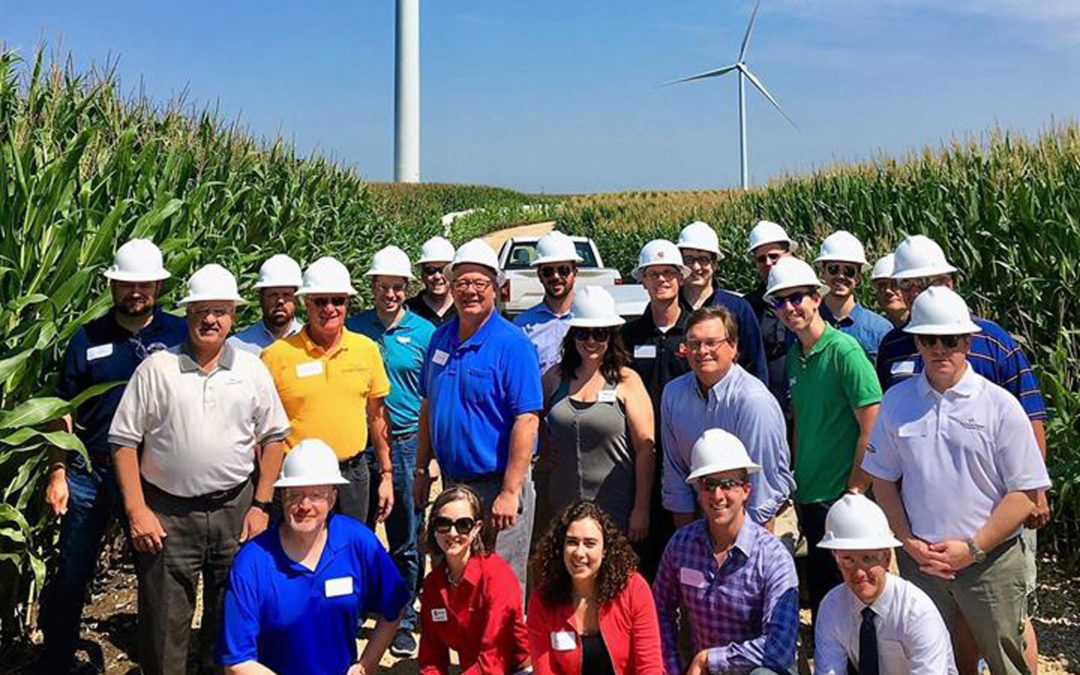
by Jim Boullion | Sep 4, 2018 | Biogas, Events, RENEW Wisconsin, Renewables, Solar, Utilities, Wind
Quilt Block Wind Farm
On August 9th, Vanessa Tutos, Director of Government Affairs for EDP Renewables hosted me and a large group of legislators, legislative staff and other interested people on a tour of their Quilt Block Wind Farm near Darlington, Wisconsin.
During a pre-tour briefing, Vanessa and the EDP Renewable staff gave an overview of the facility and how it works. Darlington Mayor Dave Breunig also participated in the briefing, explaining the many benefits that the Quilt Block facility brings to the local communities, including not only the town and county tax revenues, but the good paying jobs at Quilt Block and the many community businesses that benefit such as restaurants, hotels and other shops.
In attendance were State Senator Howard Marklein and Rep. Todd Novak. Legislative staff: Garrett Huffman, Rep. Kuglitsch (Assembly Utilities Committee Chair); Kyle Koenen and JJ Sherman, Sen. Kapenga staff; Brian Radday, Sen. LeMahieu staff (Senate Utilities Committee Chair); Evan Miller, Sen. Cowles staff (Senate Energy Committee Chair); Dave Breunig, Mayor of Darlington; Alex Ignatowski, Wis. Public Service Commission; Ryan Owens, Tommy Thompson Center on Public Leadership – UW Madison; Jon Hochkammer, Wisconsin Counties Association; Rob Richard, Wisconsin Farm Bureau; Tim Hoven, EDPR
School Sisters of St. Francis
On Tuesday, August 22nd, the Wisconsin Association of Energy Engineers invited me and Jane McCurry of the RENEW Wisconsin staff to tour something old and something new, all in one location, the School Sisters of St. Francis campus in Milwaukee. The Sisters recently installed a 375-kW solar array with 1,086 panels on several of their buildings.
Sister Carol Rigali, Coordinator of the province leadership team, specifically asked that the panels be made in the USA. As Mike Cornell of Arch Electric explained, they acquired the panels from Seraphim Solar USA, from Jackson, Mississippi. Sister Carol said that St. Francis expects to save $1.5 million in energy costs over the life of the system, but that was only one reason they did the project.
She noted that in his 2015 encyclical Laudato Si, Pope Francis specifically mentioned installing solar panels as one way to care for creation. “This solar energy project will enable us to lessen our energy consumption and to invest in our care of the earth.” The chapel was finished in 1914 but looks as amazing as the day it was built. The art and architecture inside compare to some of the best churches anywhere in the world. Now they have a state-of-the-art solar generation system that will help them achieve their mission now and into the future. Preserving the past by embracing the future! Nicely done Sisters!
Wisconsin Agriculture Coalition
On Monday, August 27, I was joined by RENEW Wisconsin’s Executive Director Tyler Huebner, Scott Smith from Madison Gas & Electric and Neil Palmer from Invenergy to give a briefing to the Wisconsin Agriculture Coalition about the latest developments in renewable energy and how it may affect their members. The Agriculture Coalition is a group of association executives and government affairs staff who meet regularly to discuss legislative and regulatory issues in which they have a common interest.
I opened the meeting by discussing the changing economics and politics of renewable energy and let them know that they are going to be seeing a lot of activity in Wisconsin. Tyler then gave an overview of renewables in Wisconsin that will especially impact farms and agriculture related businesses such as solar and wind farms and biogas generation. Scott gave the utility perspective on why they are all adding large scale renewables to their portfolio and the benefits that they see for their customers. In particular, he noted that the driving force was the impressive price drop of over 75% for solar power in the last 10 years.
Finally, Neil spent some time explaining how Invenergy goes about developing a utility scale solar project, from identifying good locations with access to substations and landowners with enough flat, open land who are interested in leasing their property, to the steps and timing of the regulatory process. We also had a good discussion about the “frequently asked questions” that they may be hearing from their members and how to answer them. In summary, everyone in attendance received a good, general understanding of the amazing changes that are happening in the renewable industry and that RENEW Wisconsin is their source for reliable, fact-based information!
Members of the Ag Coalition include:
- Wisconsin Farm Bureau Federation
- Wisconsin Farmers Union
- Dairy Business Association
- Wisconsin Cheese Makers Association
- Midwest Food Products Association
- Wisconsin Agri-Business Association
- Wisconsin Association of Professional Agricultural Consultants
- Wisconsin Cattlemen Association
- Wisconsin Pork Association
- Wisconsin Soybean Association
- Wisconsin Potato and Vegetable Growers Association
- Wisconsin Corn Growers Association
- The Cooperative Network Associations
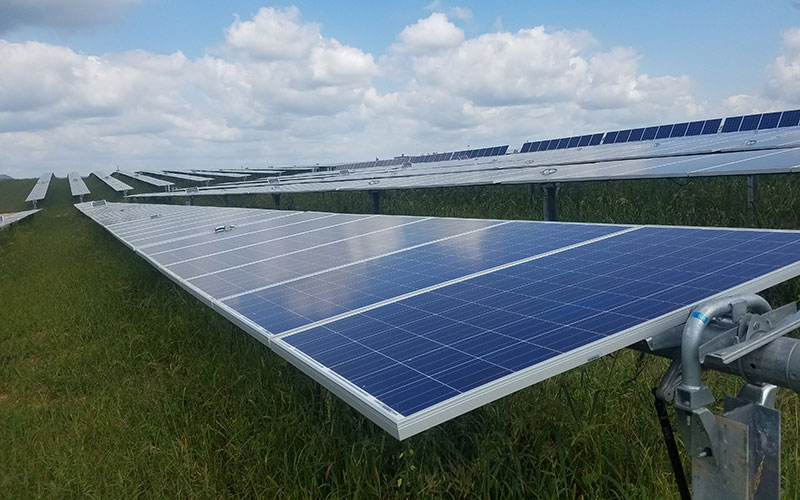
by Michael Vickerman | Aug 22, 2018 | Local Initiatives, RECs, Renewables, Solar
A recently signed contract between the City of Madison and OneEnergy Renewables, LLC, a solar developer headquartered in Seattle, will result in the construction of five community solar arrays totaling 14 megawatts (MW) next year in western Wisconsin. The City’s decision to provide financing to this project represents the largest commitment to date by a single Wisconsin customer to expanding solar capacity here.
Expected to begin operating in mid-2020, OneEnergy’s five arrays should produce about 20 million kilowatt-hours of clean electricity a year over its operating life. That output equates to more than one third of the City of Madison’s own consumption.
OneEnergy’s solar arrays will be built in the service territories of the municipal utilities serving Argyle, Cumberland, Elroy, Fennimore, and New Lisbon. These five utilities will receive the electricity at a price comparable to what they currently pay for wholesale power. However, under the city’s contract with OneEnergy, Madison will receive 25 years of renewable energy credits, or RECs, associated with the project’s output.
The $1.4 million contract will move Madison substantially closer to its goal of sourcing 100% of the electricity used for city operations from renewable energy sources. Madison is one of three Wisconsin municipalities that adopted a 100% renewable energy goal. The others are Eau Claire and Middleton.
Approved by Madison’s Common Council in July, the city’s REC purchase is an essential element in the overall financing for OneEnergy’s solar project. Though the power from the arrays will flow to five different municipal utilities, the agreed-upon purchase price will not, by itself, pay for the project’s full cost. But with the additional revenue stream coming from the City’s REC purchase, the developer should have no difficulty in securing outside investors to participate in the project.
“Through this creative arrangement, new community solar projects totaling 14 MW will move from the drawing boards out into the western Wisconsin landscape,” said RENEW policy director Michael Vickerman. “At a remarkably low cost, the City will expand solar generating capacity in Wisconsin by 15%, and these new sources of zero-carbon power will provide tangible benefits to the City, the rural communities hosting these arrays, and our planet.”
Madison’s action is the second major REC purchase by a Wisconsin customer to support the construction of community-scale solar projects. Last November, LaFarge-based Organic Valley Cooperative, the nation’s largest cooperative of organic farmers, entered into a similar arrangement with OneEnergy to purchase RECs from 12 MW of solar capacity serving another group of small municipal electric utilities. Through that transaction Organic Valley expects to reach its goal of being 100% renewably powered by 2020.
Constructing both sets of arrays will involve only one mobilization of construction equipment and crews. According to OneEnergy, combining the Organic Valley and City of Madison projects into one coordinated build-out will reduce construction costs, which helped make project participation more affordable for both the utility off-takers and the REC purchasers.
OneEnergy is also developing a 4 MW project next to Middleton’s airport with the aim of supplying the City of Middleton and a Madison-area business with solar electricity.
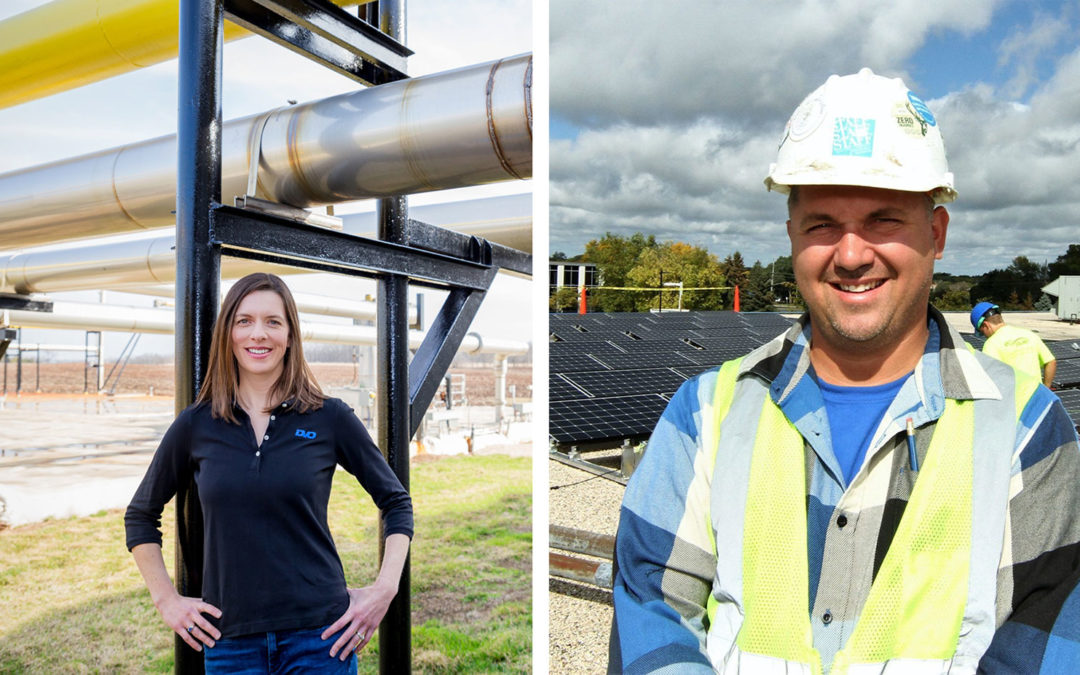
by Jodi Jean Amble | Aug 8, 2018 | Biogas, Jobs, Renewables, Solar, Sustainability, Wind
More than 75,000 Wisconsin residents now work in clean energy industries, including individuals in all 72 counties, according to a new analysis of energy jobs data from Clean Energy Trust (CET) and the national, nonpartisan business group E2 (Environmental Entrepreneurs). Wisconsin’s clean energy workforce employs more than all the waiters and waitresses, computer programmers, lawyers and web developers in Wisconsin combined, according to Department of Labor Employment Statistics.
Energy efficiency once again led all clean energy sectors in Wisconsin, employing 62,299 workers – accounting for 8 in ten of all clean energy workers.
Renewable energy generation came in second with over 5,600 jobs – led by solar and wind (5,351).
“Wind, solar, and energy efficiency are the lowest-cost options for utility companies and our state’s homes, businesses, and public-serving organizations. Wisconsin has a tremendous job creation opportunity because these clean energy technologies are now cost-effective and ready for prime-time,” said Tyler Huebner, Executive Director of RENEW Wisconsin.
Across the entire 12-state region, Clean Jobs Midwest found that clean energy employment totaled 714,255 at the end of last year.
Key findings about Wisconsin’s clean energy workforce include:
• Renewable energy, led by wind and solar, employs 5,660 Wisconsin residents
• Over 2,500 Wisconsin residents now work in grid modernization and energy storage
• The majority of Wisconsin’s clean energy jobs are in construction and manufacturing (75.30%)
• Clean fuels and clean vehicle technologies employ 4,565 workers
• Employers project 2.0% clean energy job growth in 2018
• Small businesses are driving Wisconsin’s clean energy sectors, with 67.90% of clean energy businesses employing fewer than 20 individuals.
• 11% of Wisconsin residents employed in clean energy are veterans
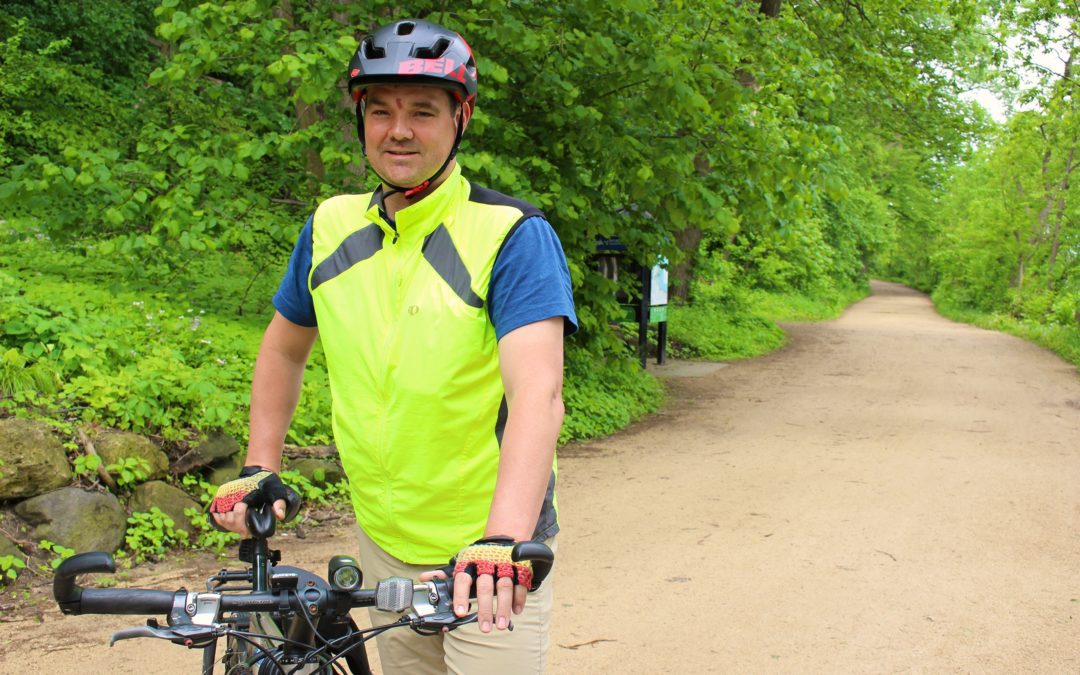
by Jodi Jean Amble | Aug 3, 2018 | Solar
MADISON, Wis. – A University of Wisconsin-Madison professor is biking 2,000 km around the Upper Midwest beginning on July 28th to increase awareness of solar energy and raise funds for a solar energy project in Puerto Rico.
The bike journey, known as #BiketheSun, will take James Tinjum, Ph.D., of UW’s Department of Engineering Professional Development to 50 solar energy sites across Wisconsin, Illinois, Iowa and Minnesota. Riding an electric bike prototype with a plan to bike 160 km per day, the trip will take Tinjum about two weeks to complete.
“Solar is an energy solution that provides clean, renewable, domestic energy across the U.S.,” said Tinjum. “In the last year, if you include rooftop solar, about 2.5 percent of our nation’s electrical supply came from solar. Although this energy source is growing, there is still a lot of room for expansion.”
Along with bringing attention to solar energy, the purpose of #BiketheSun is to raise funds for Solar Para Niños, a solar installation project at a non-profit shelter in Puerto Rico for abused children. The panels will reduce the shelter’s energy costs by as much as $1,000 per month, allowing the shelter to invest more money into educational and counseling services the children. The project will help provide long-term, sustainable relief after Hurricane Maria devastated the island last September.
“Puerto Rico’s power grid was completely knocked out during the hurricane and electricity was not restored across the island for as long as nine months after. Renewable, distributed energy sources like solar will provide more resilient and reliable power, particularly for when another natural disaster occurs,” Tinjum said.
Puerto Rico has the highest electricity rates in the U.S., according to Tinjum. Even though the island has excellent solar resources, it produces over 95 percent of its electrical energy by burning imported natural gas, coal and oil – which are not only expensive, but environmentally unsustainable.
“With the installation and promotion of more renewable sources such as solar energy, institutions like the children’s shelter will substantially reduce their monthly energy bill, as well as move toward a more sustainable use of energy,” he said.
Last summer, Tinjum embarked on a 2,000-km bike ride called #BiketheWind to raise awareness about wind energy, so he’s familiar with long trips triggered by good causes. To prepare for this year’s ride, Tinjum is biking upwards of 24 hours a week, getting in hours by biking to “everything,” including work, groceries and intramural soccer matches.
Tinjum departs for his journey on Saturday, July 28 from Madison, Wisconsin.
To keep up with his journey, visit solarparaninos.com/bikethesun and follow #BiketheSun on social media. Visit solarparaninos.com/donate to donate to the Solar Para Niños project fund.
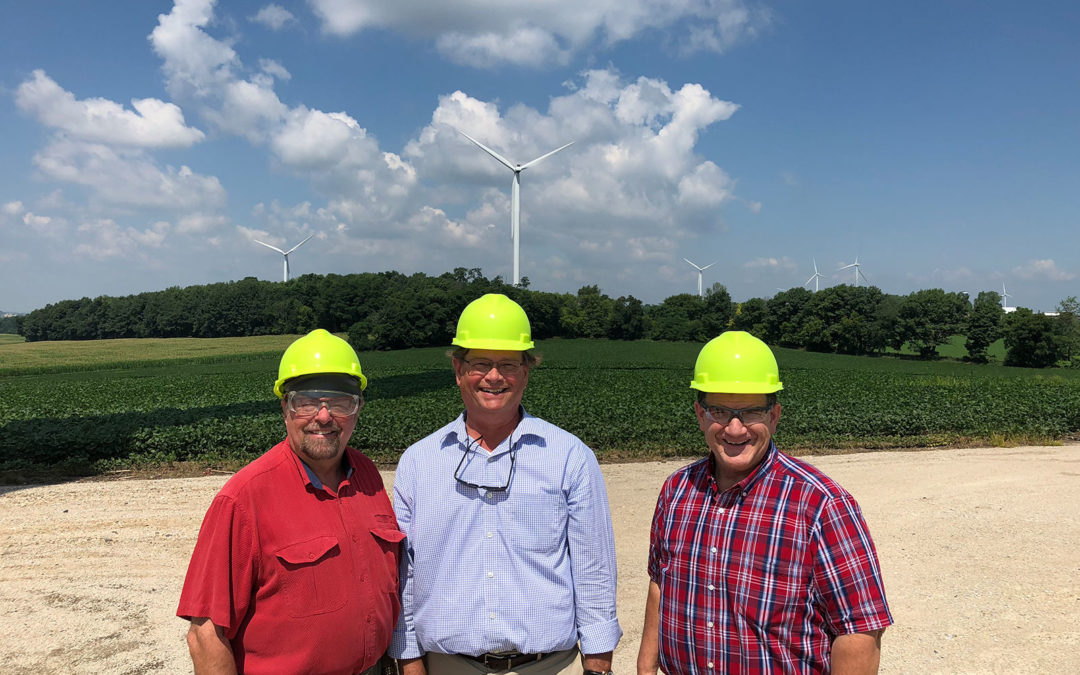
by Jim Boullion | Jul 30, 2018 | Events, Hydroelectric, RENEW Wisconsin, Renewables, Solar, Wind
Cedar Ridge Wind Farm
On July 24th Alliant Energy hosted a tour of their Cedar Ridge Wind Farm in Fond du Lac County for several state legislators to discuss not only wind, but all of the latest developments in renewable energy. Built in 2008, Cedar Ridge was one of the first wind installations in the state. Alliant Energy owns and operates this site of 41 turbines that has a capacity of generating 68 mW of electricity, enough to power 17,000 homes. In its 10 years of existence, Alliant calculates that the electric power generated by these wind turbines allowed them to avoid burning enough coal to fill a 99-mile-long coal train! Alliant currently owns 569 mW of total wind power, but because of falling costs, efficiency gains of the turbines, and inexpensive operations and management, they expect to invest in an additional 1,150 mWs of wind generation by 2021. Representatives Bob Kulp and Rick Gundrum came away impressed and posted very positive comments online about the tour and the many developments in renewable energy.
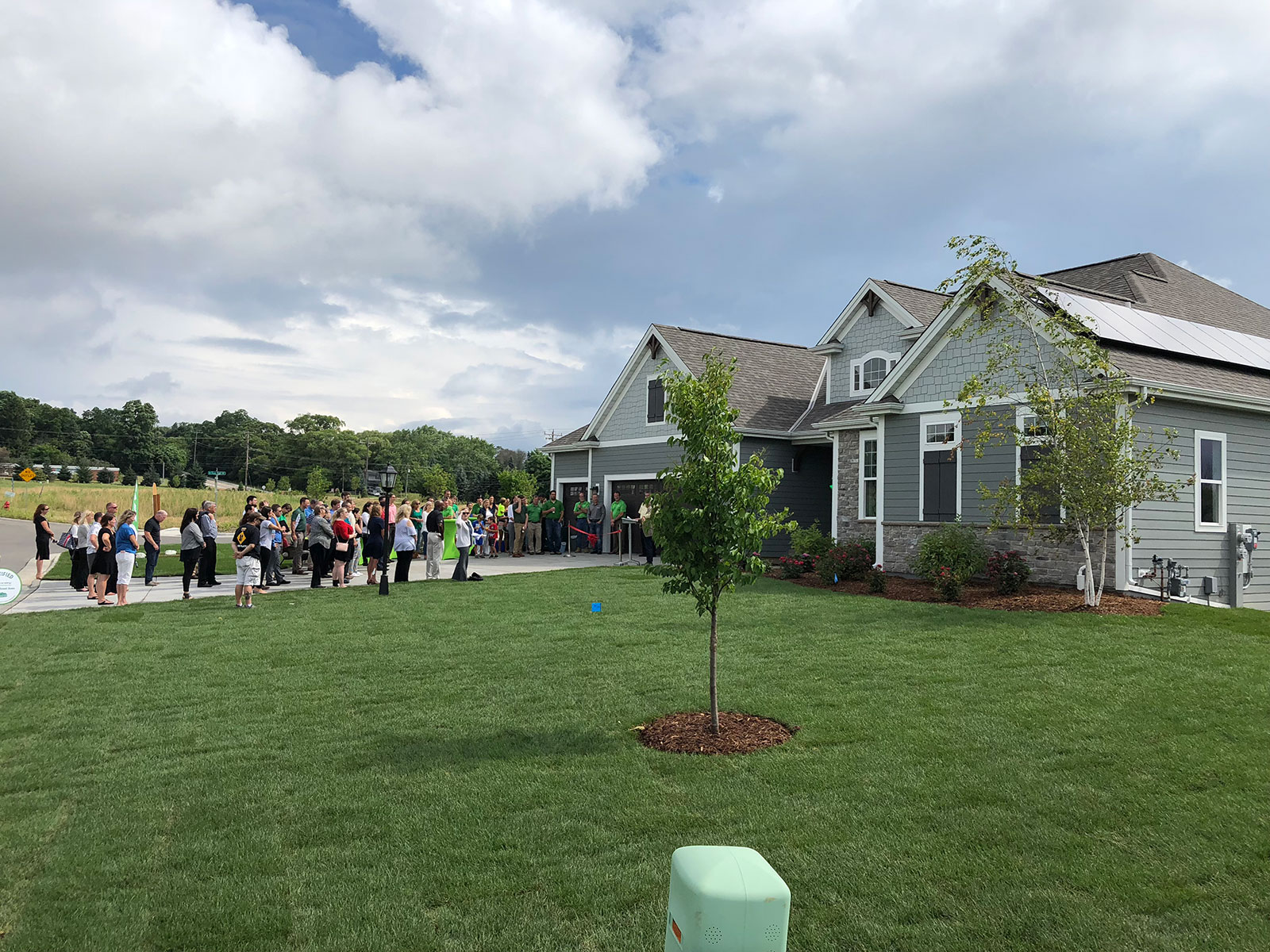
Tim O’Brian Homes Net Zero Community
On July 20th I visited a ribbon cutting for the new Tim O’Brian Homes Net Zero Community in New Berlin. This all-solar subdivision is the first of its kind in Wisconsin. In partnership with Neumann Companies and SunVest Solar, Inc., they are developing the Red Fox Crossing subdivision with a focus on sustainability and energy efficiency. Not only is every home in the subdivision designed from the ground up to include 6 to 8 kW photovoltaic solar arrays, but they are also certified ENERGY STAR® V3 National Qualified Homes. “Buyers are looking for ways to save on their true cost of homeownership,” says Angela Cooper, Milwaukee Division President of Tim O’Brien Homes. “The upfront costs of building a net zero home might be slightly more than a code-built home but the money saved in monthly utility bills results in an overall less expensive home.” The subdivision has been popular, with half of the 34 units already sold. “Red Fox Crossing has the potential to be the turning point in building a more sustainable community in Wisconsin, versus focusing on only one home at a time,” says Tim O’Brien, President of Tim O’Brien Homes. ”

Badger Hydroelectric Plant
On July 13th I joined State Senator Rob Cowles (District 2-Green Bay) and Representative Dave Murphy (District 56-Greenville) on a tour of the Badger Hydroelectric plant in Kaukauna. The visit was hosted by the Kaukauna Municipal Utility, a member of WPPI Energy. As noted in this WBAY news story, the visit was designed as a discussion about renewable energy of all kinds. Hydroelectric power was one of the first, and least expensive sources of electric power. The Kaukauna facility is 110 years old and had a major upgrade in 2013, giving it a capacity of 7 mW of power, up 40% from the capacity of its two old powerhouses. During the meeting we discussed the dropping prices for wind and solar power and the tremendous amount of renewable energy that is currently listed on the 4-year MISO planning queue. It was noted that WPPI Energy, Dairyland Power and the investor owned utilities are looking to close their coal burning power plants and invest in utility scale wind and solar projects. They are doing this because wind and solar cost less than coal and the rising customer demand for renewable energy. This competitive, market-driven demand for renewable energy has led Wisconsin to easily surpass the 10% Renewable Portfolio Standard (RPS) that was established by the state legislature in 2006, and shows no signs of slowing!

Governor Walker Helps Energy Bank Announce Renewable Energy Lighting
On July 9th I was invited by Energy Bank, Inc. to attend the unveiling of a new product called FUSION. Neal Verfuerth, owner of Energy Bank, invented this new lighting system that uses the DC power output from photovoltaic solar panels to directly energize LED fixtures – without conversion to AC. Governor Scott Walker gave the keynote speech where he said Wisconsin companies understand the need to keep their peak energy demand low and reduce the overall cost of energy to be economically viable. Walker said that businesses understand that “to be environmentally sustainable, you need to be economically sustainable”, and products like FUSION make that happen. The Governor was excited about innovative and high-tech companies like Energy Bank locating in Wisconsin, creating the new era technologies that will create jobs and attract millennial workers to Wisconsin. I had a few minutes to speak with both the Governor and Representative Paul Tittl (District 25-Manitowoc) at the end of the event about the exciting advancements and fast falling prices that renewable energy has had in the last few years. They were very interested and are looking forward to working with RENEW to help keep that momentum going.
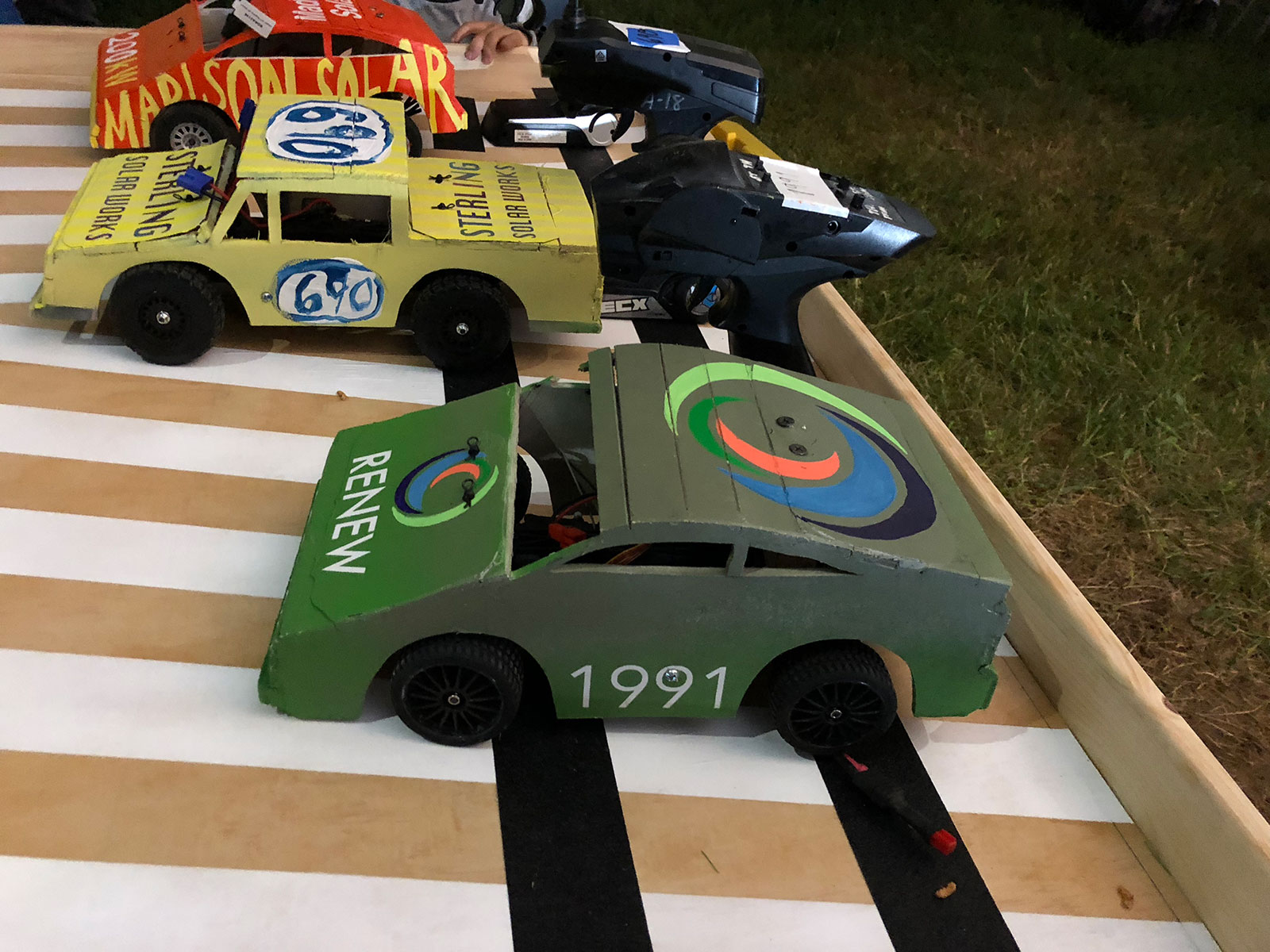
The 29th Annual Energy Fair
On the weekend of June 15-18 I had the pleasure of visiting the MREA Energy Fair in Custer. This was my first visit to the Energy Fair and all I can say is that I was blown away! They had an amazing number of great seminars (over 250) on renewable energy, energy conservation and sustainable practices of all kinds. I was able to see, sit in and learn about many different electric vehicles (over 70 of them were on-site) and discuss with EV aficionados what the exciting future of transportation might look like. There were also over 450 exhibitors, presenters and sponsors from around the country. There were great speakers, entertainment and interesting people everywhere you looked. Everyone was up-beat and excited about renewable energy and how quickly it is taking over the energy market. Finally, the most fun part of the weekend was having me drive the RENEW Wisconsin electric demolition derby car. I won my initial heat and was in the final event. A controversial call by the umpires and a slight miscalculation on my part kept me out of the winner’s circle, but at the end of the evening everyone was a winner and we all had a great time!!
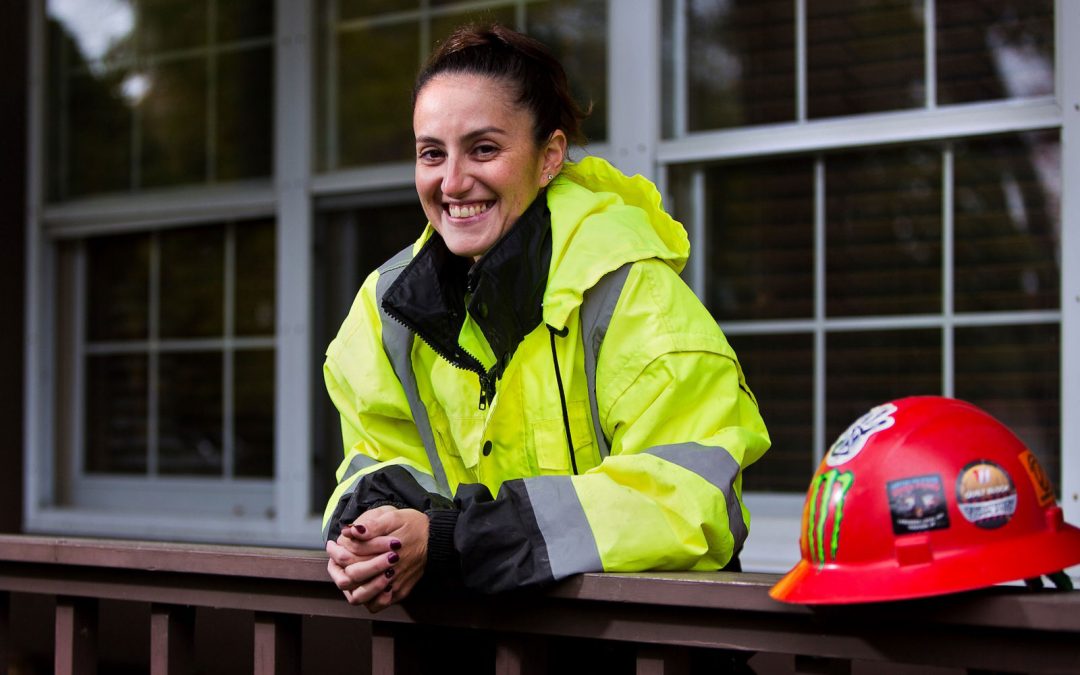
by Jodi Jean Amble | Jul 25, 2018 | RENEW Wisconsin, Renewables, Solar, Wind
Last fall, I was asked to help promote a series called Names behind the Numbers, profiling Wisconsin’s renewable energy workers. One of the interviews featured April Smith (pictured above), a construction worker on the Quilt Block Wind Farm in Darlington, WI. In describing her work she said “All the people, the company, and the community — everyone looked out for each other” and I thought “that’s Wisconsin.”
I grew up in the northeast corner of Iowa County, in the Wisconsin River valley in a small town called Arena. My grandmother cleaned houses, my dad was a mechanic turned landscaper, and my uncles worked road construction. I was surrounded by the grit and community that defines the Wisconsin work ethic; I was taught to work hard, work together, and get the job done.
Now I am one of Wisconsin’s clean energy workers. I joined the RENEW Wisconsin staff a year ago with an untraditional background: an arts education, a theater and music career, and eight years of marketing for a general contractor in Chicago. I knew little about renewable energy, but I cared about the environment and wanted to help build a cleaner future for my children.
According to the Department of Energy’s 2017 US Energy and Jobs Report Wisconsin, over 67,000 people are already working in clean energy, and renewable energy job growth is six times faster than overall job growth in the state. Wisconsin has the opportunity to increase renewable energy substantially in the coming decades, and create tens of thousands of jobs along the way.
After April’s story was published, I was able to attend the Quilt Block dedication and ribbon cutting in Darlington, WI. I witnessed firsthand a community (comprised of local landowners, businesses, educators, government officials, and EDP Renewables) working together to build a 98 MW wind farm, enough to power 25,000 Wisconsin homes with clean energy. This project created approximately 100 full-time jobs during construction and 12 permanent jobs.
I recently attended an outdoor BBQ at the local office of the proposed Badger Hollow Solar Project in Monfort, WI. This was an opportunity for local landowners to get together and see which of their neighbors would be growing a solar crop. There, I met Tracy Fillback, the local liaison hired to address questions and concerns from the landowners and the community as this project progresses. She spent the last few years at home raising her children and now she’s starting a new chapter as part of of the Badger Hollow Solar project. She is another example of renewable energy job opportunity in Wisconsin.
Wind developers are scoping out new projects in rural parts of the state and in recent weeks two proposals for large scale solar farms have joined Badger Hollow Solar at the review stage of development. While we can’t predict the exact number of jobs this will mean for Wisconsin, these companies and workers will spend millions of dollars on locally-sourced gravel, concrete, construction supplies, food, lodging and other services. Increasing renewable energy is one of the best economic development moves Wisconsin could make, particularly for its rural communities.
Wisconsin’s renewable energy workers are building a cleaner future for our children and they’re doing it the Wisconsin way; with tenacity, community, and hard work. Renewable energy can support our local economies and be as homegrown as the crops in our fields, if our communities can continue to embrace the possibilities.










